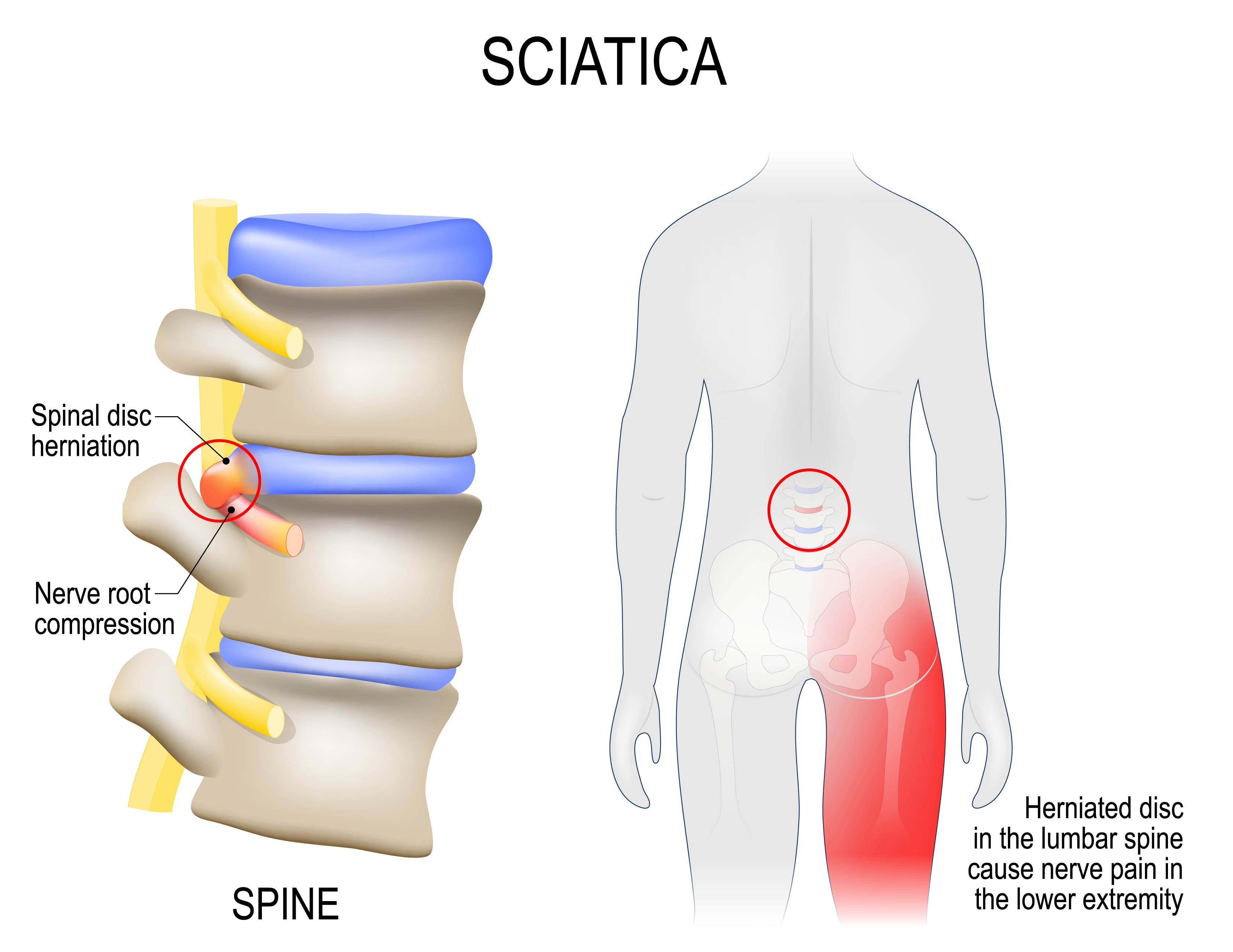Understanding Sciatica
Sciatica is pain that radiates along the path of the sciatic nerve, the largest nerve in the lower body. The sciatic nerve branches off the spinal cord in the low back into the buttocks and down the back of the legs. Therefore, pain from sciatica can be felt anywhere on the back of your lower body, even down to the foot. Sciatica usually affects only one side of the body.
Sciatica pain can occur from one of many different underlying conditions. Therefore, it is important to consult with your physician and healthcare team to find and treat the root of your sciatica pain.
What causes sciatica?
Sciatica is best described as a symptom, rather than a diagnosis, caused by an underlying issue. The diagnoses for these underlying issues include:
- Disc herniation (bulging disc)
- Spinal stenosis (narrowing of the spinal canal around the spinal cord)
- Degenerative disc disease
- Spondylolisthesis
- Arthritis
While disc herniation is the most common cause of sciatica, the commonality among all these conditions is that they involve pressure on the spinal nerve root coming from the structures in the spinal column. For example, a bulging intervertebral disc protrudes from the intervertebral space and places pressure on the nerve root. Research suggests that sciatica pain arises not only from the pressure, but also from the subsequent inflammatory and immune responses.

The type of sciatica that involves the spinal column and results from nerve root compression is sometimes referred to as “true sciatica.” There are other conditions outside of the spinal column, like sacroiliac joint dysfunction or piriformis syndrome, that can cause sciatica-like symptoms. But these conditions are not considered to be “true sciatica.”
What does sciatica feel like?
Radiating pain is the most common complaint of sciatica. Also known as radicular pain, radiating pain refers to pain that follows the path of a nerve. In the case of the sciatic nerve, it travels from the lower back distally to the buttock, thigh, calf, and foot.
People with sciatica may also describe the pain as sharp, burning, shooting, or tingling (i.e., pins and needles). In some cases, the pain may be accompanied by numbness or weakness in parts of the leg.
People with sciatica often describe the pain as severe. However, once the root issue causing pain is identified and treated, the pain will usually be reduced and/or resolved in just a few weeks.
How do you treat sciatica?
Most treatment for sciatica is conservative, meaning it can be treated with non-surgical methods, like exercise and physical therapy.
Treatments vary depending on the underlying cause of sciatica. Work with your physician to determine the underlying cause. The goals of treatment for true sciatica (sciatica that involves the spinal column and results from pressure on the nerve root) are:
- Reducing pain
- Decreasing pressure on the nerve root
- Improving mobility
We have the brace you need
Back braces assist in reaching sciatica treatment goals. Examples of back braces that treat sciatica pain are the Elite Air Decompression LSO, the Evergreen™ 621 SI Belt, and the EXOS® FORM™ II 621. Read more about these types of back braces here.
We’re here to help answer your questions about which back braces can be used to treat your condition. Contact us today to learn more.
Written by Dr. Jenny Hunnicutt
Dr. Jenny Hunnicutt is a licensed athletic trainer with a PhD in Health and Rehabilitation Science. As the owner of Hunnicutt Writing and Consulting, LLC, she collaborates with global institutions, spearheading innovation and research among professionals and businesses in Orthopedics and Sports Medicine. Learn more at https://drhunnicutt.com.
Braces and Products Covered by Medicare
Browse ProductsRecent Posts
- Spinal Decompression at Home: What It Is, How It Works, and Whether It’s Right for You
- Manage Osteoarthritis Progression With a Quality Knee Brace
- Product Highlight: Aspen Active™ P-TLSO
- Understanding Radiculopathy: Causes, Symptoms, & Treatment Options
- Alternatives to Back Surgery: What you Should Know
Topics
- Back Braces (39)
- Knee Braces (31)
- Medicare Beneficiaries (31)
- Pain (24)
- Non-Opioid (22)
- Medical Providers (19)
- Lower back pain (11)
- Product Highlight (11)
- Sciatica (11)
- Muscle Spasms (9)
- Decompression (8)
- Lumbago (8)
- Degenerative disc disease (6)
- Lumbar Spinal Stenosis (6)
- Spinal Stenosis (6)
- Working with your doctor (6)
- Fracture healing (5)
- Herniated Nucleus Pulposus (5)
- Bulging or herniated disc (4)
- Quadratus Lumborum Syndrome (4)
- SI Joint (4)
- SI Joint Dysfunction (4)
- Spondylolysis (4)
- Wrist Pain (4)
- Bone Growth Stimulator Therapy (3)
- Bone Growth Stimulators (3)
- Carpal Tunnel Syndrome (3)
- Neuromuscular Electrical Stimulation (NMES) (3)
- Unicompartmental Osteoarthritis (OA) (3)
- Wrist Brace (3)
- wrist tendinitis (3)
- Braces for Golf (2)
- Electrical Stimulation (2)
- Failed Spinal Fusion Syndrome (2)
- Kyphosis (2)
- Lumbar compression fractures (2)
- Radiculopathy (2)
- Spondylolisthesis (2)
- Supine Cervical Traction (2)
- Total Knee Replacement (2)
- Wrist Braces (2)
- Ambulatory Cervical Traction (1)
- Arthritis (1)
- Braces for skiing (1)
- Cervical Traction (1)
- De Quervain Syndrome (1)
- Digital DME Orders (1)
- Knee Brace Accessory (1)
- Knee Suspension Wrap (1)
- Knee brace support for skiing (1)
- Medicare Scam (1)
- Muscle Atrophy (1)
- PCL (1)
- Patellofemoral Pain Syndrome (1)
- TLSO (1)
- Ulnar Tendinitis (1)
